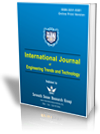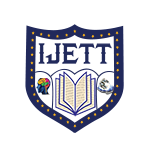Additive Protocol Layer (APL) for the Communication Between Heterogeneous Machines
Additive Protocol Layer (APL) for the Communication Between Heterogeneous Machines |
||
 |
 |
|
| © 2025 by IJETT Journal | ||
| Volume-73 Issue-1 |
||
| Year of Publication : 2025 | ||
| Author : Youssef Shawky Othman, Mohamed Abo Rezka, Ehab Kamel Abousaif, Yasmine N. M. Saleh |
||
| DOI : 10.14445/22315381/IJETT-V73I1P129 | ||
How to Cite?
Youssef Shawky Othman, Mohamed Abo Rezka, Ehab Kamel Abousaif, Yasmine N. M. Saleh, "Additive Protocol Layer (APL) for the Communication Between Heterogeneous Machines," International Journal of Engineering Trends and Technology, vol. 73, no. 1, pp. 336-346, 2025. Crossref, https://doi.org/10.14445/22315381/IJETT-V73I1P129
Abstract
Global society faces serious threats from both natural and man-made disasters that have frequently occurred lately, such as the devastating earthquake in Morocco and Libya hurricane "Daniel". Various machines such as robots, autonomous vehicles, and drones have become important and effective tools in information gathering and disaster response, particularly in search and rescue operations. However, several issues are associated with machines, such as heterogeneity and the lack of a communication protocol designed to facilitate communication among them. The purpose of this study is to design an Additive Protocol Layer (APL) to support the communication between heterogeneous machines (HM). The Cooja simulator is used to simulate the proposed protocol. The performance of the protocol will be measured for different scenarios.
Keywords
Robots, Drones, Autonomous vehicles, Internet of things, Networks.
References
[1] Rubén Martín García et al., “Urban Search and Rescue with Anti-Pheromone Robot Swarm Architecture,” 2021 Telecoms Conference (ConfTELE), Leiria, Portugal, pp. 1-6, 2021.
[CrossRef] [Google Scholar] [Publisher Link]
[2] Adam Williams, Bijo Sebastian, and Pinhas Ben-Tzvi, “Review and Analysis of Search, Extraction, Evacuation, and Medical Field Treatment Robots,” Journal of Intelligent and Robotic Systems, vol. 96, no. 3, pp. 401-418, 2019.
[CrossRef] [Google Scholar] [Publisher Link]
[3] Siobhán Grayson, “Search and Rescue Using Multi-Robot Systems,” School of Computer Science and Informatics, University College Dublin, pp. 1-14, 2014.
[Google Scholar] [Publisher Link]
[4] Luca Barbieri et al., “Decentralized Federated Learning for Extended Sensing in 6G Connected Vehicles,” Vehicular Communications, vol. 33, 2022.
[CrossRef] [Google Scholar] [Publisher Link]
[5] Xiaosha Chen et al., “Deep-Learning-Based Intelligent Intervehicle Distance Control for 6G-Enabled Cooperative Autonomous Driving,” IEEE Internet of Things Journal, vol. 8, no. 20, pp. 15180-15190, 2020.
[CrossRef] [Google Scholar] [Publisher Link]
[6] Yuxuan Liu et al., “Reinforcement Learning Based Two-Level Control Framework of UAV Swarm for Cooperative Persistent Surveillance in an Unknown Urban Area,” Aerospace Science and Technology, vol. 98, 2020.
[CrossRef] [Google Scholar] [Publisher Link]
[7] Dai Quoc Tran et al., “Damage-Map Estimation using UAV Images and Deep Learning Algorithms for Disaster Management System,” Remote Sensing, vol. 12, no. 24, pp. 1-15, 2020.
[CrossRef] [Google Scholar] [Publisher Link]
[8] Saeed Hamood Alsamhi et al., “Multi‐Drone Edge Intelligence and SAR Smart Wearable Devices for Emergency Communication,” Wireless Communications and Mobile Computing, vol. 2021, no. 1, pp. 1-12, 2021.
[CrossRef] [Google Scholar] [Publisher Link]
[9] C.C. Sobin, “A Survey on Architecture, Protocols and Challenges in IoT,” Wireless Personal Communications, vol. 112, no. 3, pp. 1383-1429, 2020.
[CrossRef] [Google Scholar] [Publisher Link]
[10] Zhiyong Feng et al., “Joint Communication, Sensing, and Computation Enabled 6G Intelligent Machine System,” IEEE Network, vol. 35, no. 6, pp. 34-42, 2021.
[CrossRef] [Google Scholar] [Publisher Link]
[11] Karthik Kumar Vaigandla, Radha Krishna Karne, and Allanki Sanyasi Rao. “A Study on IoT Technologies, Standards and Protocols,” IBMRD's Journal of Management and Research, vol. 10, no. 2, pp. 7-14, 2021.
[CrossRef] [Google Scholar] [Publisher Link]
[12] V. Vibin, P. Sivraj, and V. Vanitha, “Implementation of In-Vehicle and V2V Communication with Basic Safety Message Format,” 2018 International Conference on Inventive Research in Computing Applications (ICIRCA), Coimbatore, India, 2018.
[CrossRef] [Google Scholar] [Publisher Link]
[13] Holly Yanco, and Lynn Andrea Stein, An Adaptive Communication Protocol for Cooperating Mobile Robots, From Animals to Animats, MIT Press Direct, vol. 2, pp. 478-485, 1993.
[CrossRef] [Google Scholar] [Publisher Link]
[14] Ryan Marcotte, “Adaptive Communication for Mobile Multi-Robot Systems,” Master's Thesis, University of Michigan Library, pp. 1-112, 2019.
[Google Scholar] [Publisher Link]
[15] Sipra Behera et al., “Wireless Characteristics Study for Indoor Multi-Robot Communication System,” Proceedings of the 1st Workshop on Complex Networked Systems for Smart Infrastructure, New York, United States, 2018.
[CrossRef] [Google Scholar] [Publisher Link]
[16] Hyun-Soo Kang et al., “Implementation of FlexRay Communication Controller Protocol and its Application to a Robot System.” Journal of the Institute of Electronics Engineers of Korea TC, vol. 45, no. 6, pp. 1-7, 2008.
[Google Scholar] [Publisher Link]
[17] Patrick Benavidez et al., “Multi-Domain Robotic Swarm Communication System,” 2008 IEEE International Conference on System of Systems Engineering, Monterey, CA, USA, 2008.
[CrossRef] [Google Scholar] [Publisher Link]
[18] İlker Ünal et al., “Adaptive Multi-Robot Communication System and Collision Avoidance Algorithm for Precision Agriculture,” Applied Sciences, vol. 13, no. 15, 2023.
[CrossRef] [Google Scholar] [Publisher Link]
[19] Haythem Bany Salameh et al., “Energy-Efficient Power-Controlled Resource Allocation for Mimo-Based Cognitive-Enabled b5g/6g Indoor-Flying Networks,” IEEE Access, vol. 10, pp. 106828-106840, 2022.
[CrossRef] [Google Scholar] [Publisher Link]
[20] Seungho Yoo et al., “Poster: A Multi-Drone Platform for Empowering Drones' Teamwork,” Proceedings of the 21st Annual International Conference on Mobile Computing and Networking, New York, United States, pp. 275-277, 2015.
[CrossRef] [Google Scholar] [Publisher Link]
[21] Jingjing Wang et al., “Taking Drones to the Next Level: Cooperative Distributed Unmanned-Aerial-Vehicular Networks for Small and Mini Drones,” IEEE Vehicular Technology Magazine, vol. 12, no. 3, pp. 73-82, 2017.
[CrossRef] [Google Scholar] [Publisher Link]
[22] K.M. Manasa et al., “Design and Development of Communication Protocol for Micro Air Vehicle,” 2015 Twelfth International Conference on Wireless and Optical Communications Networks (WOCN), Bangalore, India, 2015.
[CrossRef] [Google Scholar] [Publisher Link]
[23] Chunbo Luo et al., “Unmanned Aerial Vehicles for Disaster Management,” Geological Disaster Monitoring based on Sensor Networks, pp. 83-107, 2019.
[CrossRef] [Google Scholar] [Publisher Link]
[24] A.S. Joseph Charles, and P. Kalavathi, “QoS Measurement of RPL using Cooja Simulator and Wireshark Network Analyser,” International Journal of Computer Sciences and Engineering, vol. 6, no. 4, pp. 283-291, 2018.
[Google Scholar] [Publisher Link]
[25] Meena Pundir, and Jasminder Kaur Sandhu, “A Systematic Review of Quality of Service in Wireless Sensor Networks using Machine Learning: Recent Trend and Future Vision,” Journal of Network and Computer Applications, vol. 188, 2021.
[CrossRef] [Google Scholar] [Publisher Link]
[26] Innocent Onwuegbuzie et al., “Performance Evaluation of RPL Objective Function: A Case of Contiki operation System,” Preprints, pp. 1-15, 2020.
[CrossRef] [Google Scholar] [Publisher Link]
[27] Hanane Lamaazi, Nabil Benamar, and Antonio J. Jara, “RPL-Based Networks in Static and Mobile Environment: A Performance Assessment Analysis,” Journal of King Saud University-Computer and Information Sciences, vol. 30, no. 3, pp. 320-333, 2018.
[CrossRef] [Google Scholar] [Publisher Link]
[28] Ashwini Kumar Varma et al., “A Self-Adaptive Network for Multi-Robot Warehouse Communication,” Computing, vol. 103, no. 2, pp. 333-356, 2021.
[CrossRef] [Google Scholar] [Publisher Link]
[29] Godwin Asaamoning et al., “Drone Swarms as Networked Control Systems by Integration of Networking and Computing,” Sensors, vol. 21, no. 8, pp. 1-23, 2021.
[CrossRef] [Google Scholar] [Publisher Link]

